Bukhara
 Bukhara is one of the oldest towns of the Orient (2500 years old) located in the transitory area where oasis of Zerafshan river turns into sandy desert of Kyzylkum.
Bukhara is one of the oldest towns of the Orient (2500 years old) located in the transitory area where oasis of Zerafshan river turns into sandy desert of Kyzylkum.As early as in Chinese chronicles of the 2rd c BC, Buhara is already mentioned under the name of "Bu Ho" as main city of the area called "Ghi".
According to legend, the town was founded by Siyavush – a legendary king and a hero of "Shahname" - the epic poem written by Firdausi in the 10th c. AD.
In the 9th century AD Bukhara became a capital of powerful Perisian Samanids dynasty.
It was there where famous Tajik poet Aby Abdulla Rudaki wrote his poetry in the 10th c. AD.
Bukharian insist that the legendary hero of Tukic anecdotes and people’s wit Khodja Nasreddin also was native of Bukhara.more...
It was there in Bukhara where in the 10th c. AD in the small village near Bukhara a great philosopher and scientist nowadays regarded as founder of contemporary medicine Abu Ali ibn Sina (Avicenna) was born.
Because of its favourable location at the Great Silk Route, enormous wealth and political strength, Bukhara by 16th c. AD became an internationally recognised centre of Muslim religious knowledge and education. The heritage of that time is exemplified in old Bukhara’s "999" mosques, madrasahs, minarets and mausoleums that, by their number, surpuss all other towns of the Central Asia.
Contemporary Bukhara is an administrative and industrial town and centre of the Bukhara province of Uzbekistan. Its population is more than 270 thousand.
The Fortress of Arc (VII - XIX c.c.) is the place where from Bukhara started growing and therefore is most ancient part of the city. Over its 2500 year’s history, the Arc has seen number of reconstructions and always served as a place of residence for Bukhara rulers.
The fortress occupies the territory of 35 000 m2. Today a visitor can see in the Arc some of the buildings of the past: mint court, jewellery workshop, chancellery (premier’s office), 17th c. Juma mosque and harem of the emir. Former fortress now serves as a museum allowing a traveller to dip into atmosphere of times long past.
The Poi-Kalon ensemble (translated from Persian as "at the foot of grandeur") comprises Miri-Arab madrasah (XVI c.), Kalon mosque (XV –XVI c.c.), Kalon minaret (XII c.) and Seid Alimkhan madrasah (XIX-XX c.c.).
The ensemble is really impressive. Over 45m tall minaret with its 14 decorative belts of carved bricks and terracotta, the mosque big enough to fit 10,000 prayers, high-rise portal and two turquoise domes of Miri-Arab madrasah – all decorated with splendid mosaic in geometric, floral and epigraphic patterns - give a traveller a feel of previous epoch.
The Lyabi-Hauz ensemble (XVI-XVII c.c.) is regarded as a heart of the old town. It is a lovely shady place where life seems has never stopped throughout Bukhara’s long history. The place is frequented by townsfolk and guests of the city who come there to take their time, to eat out at cafes under the shade of 500-years old mulberry trees running the perimeter of a big pool and to socialise. In fact, Lyabi-Hauz means in Persian "at the edge of a pool". Adding to the atmosphere of the place are surrounding architectural monuments of the past: Nadir Divanbegi Hanako (17th c.), Nadir Divanbegi madrasah (XVII c.) and Kukelidash madrasah (XVI c).
Chor-Minor (literally: "four minarets) is an entrance structure and what has left of a former madrasah built in 1807 by a local man called Niyazkul Halpha - a peculiar building, unique in itself not only for Central Asia but, perhapse, for the rest of the world.
The Samanids mausoleum (IX - X c.c.) is truly most ancient mausoleum of Central Asia preserved to our time. For its well-proportioned look and unique brick-work decoration the mausoleum is regarded as a gem of Central Asian architecture. The builder – Ismail Samani - and his father are buried in the mausoleum. Some historian would call the period of Samanids ruling over Mavarounnahr as "Muslim Renaissance".
Sitora-i-Mohihosa (XIX-XX c.c.) is an out-of-town summer palace built by last Bukhara emir Said Alimhan and his father Andulahad Khan. The former, being trained as cadet in Saint-Petersburg, was said to be in friendly terms with Russian Tsar Nicolas II (Romanov) and remained not unaffected by Russian culture. So he invited Russian architects to build him a palace in eclectic mixed style. The interior of the palace’s rooms are lavishly decorated in murals, plaster modelling, carved wood and mirrors as well as Russian and European make furniture.
One of the palace’s buildings (the harem) now serves as a centre for developing of traditional Bukharian needlework "suzanni".
Big garden laid out in traditional Oriental "chorbog" (cruciform) manner still is a habitat of peacocks allegedly originally introduced by Bukhara emir himself.
Other interesting monuments to see in town are Chashma-Ayub mausoleum (XII - XVI c.c.), Toki-Zargaron roofed market (XV - XVI c.c.), Magoki-Attori mosque (XII - XVI c.c.) built above foundations of Zoroastrian temple and multiple caravanserais of Bukhara.
Travellers of Muslim religious focus cannot miss visiting holy places of Bukhara. Of most important holy places to mention are: Bahautdin Nakshbandi complex (XVII - XX c.c.), Chor-Bakr necropolis (XVI c.) and Amir Kulal mausoleum (XVII c.).
Vabkent minaret (XIII c.) 30km northwest, Ulughbek madrassah (XV c.) in Gizhduvan 40km northwest, Jeyran Antelope Reserve 40km southeast of Bukhara are among sights that also may attract an inquisitive traveller.
Not least to mention is that Bukhra all its history through has always had its own highly skilled craftsmen. Today there is no corner at tourist destinations in Bukhara where one could not buy oneself a variety of high-quality local souvenirs: gilded needlework (embroidery), wool and silk carpets, silk fabrics - "shoi", "adras" and other satins, suzannies, ceramics, chased metal plates, knives and stork-like shaped scissors and a great deal of other stuff.
Bukhara photos

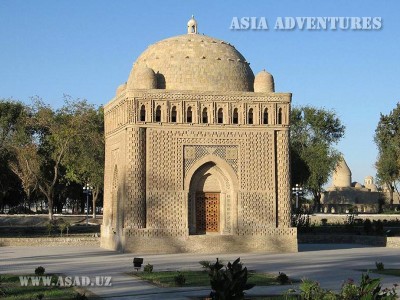
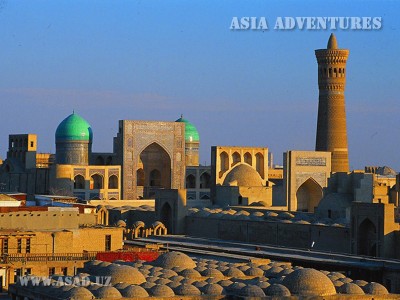
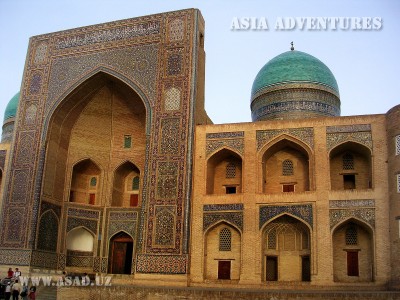
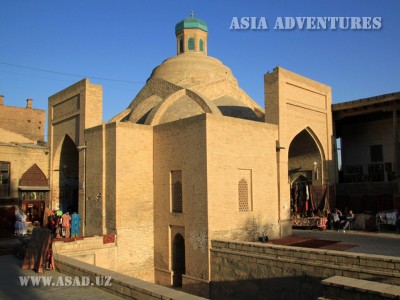
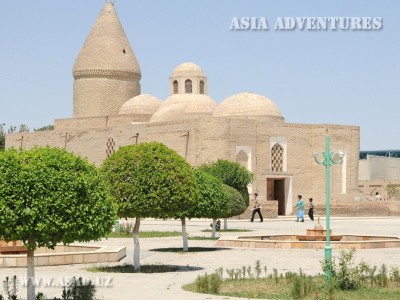
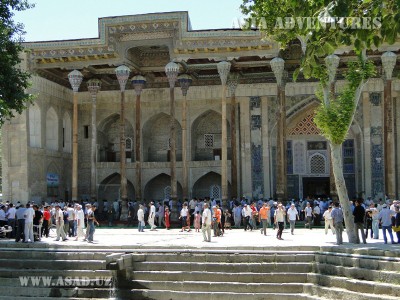
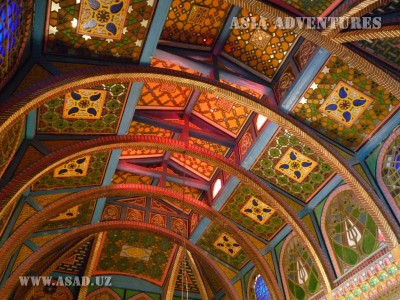
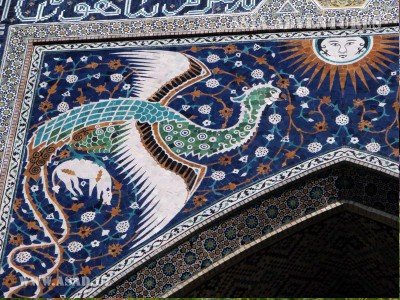
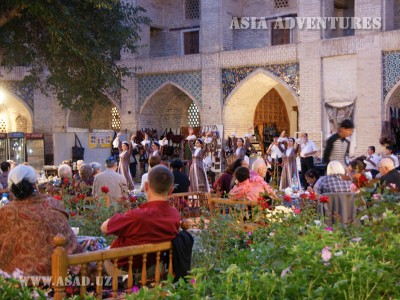

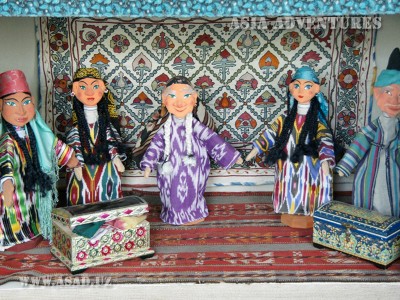

 Centralasia Adventures
+998712544100
Centralasia Adventures
+998712544100





